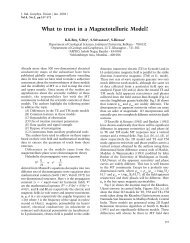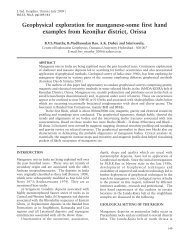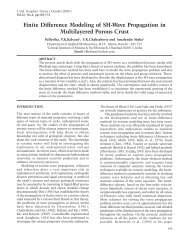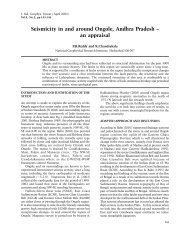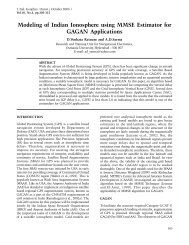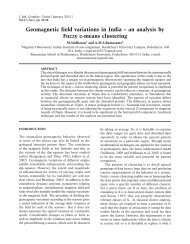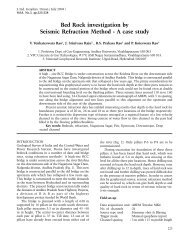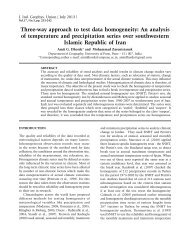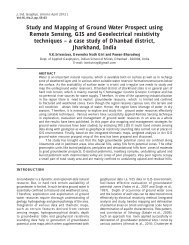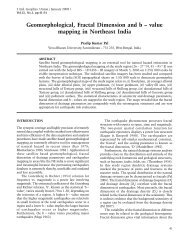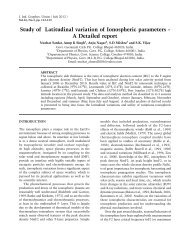U.S. De**, G. P. Singh* and D. M. Rase - IGU
U.S. De**, G. P. Singh* and D. M. Rase - IGU
U.S. De**, G. P. Singh* and D. M. Rase - IGU
Create successful ePaper yourself
Turn your PDF publications into a flip-book with our unique Google optimized e-Paper software.
U.S. De, G. P. Singh <strong>and</strong> D. M. <strong>Rase</strong><br />
from July to October. In recent times this city has<br />
attracted millions of people from neighboring states<br />
like Haryana, Punjab, Uttar Pradesh, Rajasthan<br />
<strong>and</strong> Bihar. Delhi can be divided into three major<br />
geographical regions: the Yamuna flood plain, the<br />
ridge, <strong>and</strong> the Gangetic plains. The average elevation<br />
of Delhi from mean sea level is 233 m, where as<br />
from ridge area to Yamuna flood plain, it varies from<br />
305 m to 213 m. Heavy rains in the past, over Delhi<br />
high l<strong>and</strong> ridge area have not affected the city due<br />
to natural drainage system for rain water to flow to<br />
the Yamuna river. Most populated parts of Delhi are<br />
inside the Yamuna flood plains. In the recent past<br />
thous<strong>and</strong>s of illegal colonies have emerged in this<br />
part as well as in Delhi. Many unauthorized colonies<br />
have been developed on agricultural l<strong>and</strong> by local<br />
colonizers without considering city plans, drainage,<br />
<strong>and</strong> sewerage etc. Number of surface water bodies has<br />
been reduced from 800 to 600 due to encroachment.<br />
Capital has suffered floods in 1924, 1947, 1967,<br />
1971, 1975, 1976, 1978, 1980, 1993, 1995 <strong>and</strong> 1998.<br />
In Delhi 5 persons were killed <strong>and</strong> normal life was<br />
completely paralyzed due to heavy rains on 25-26<br />
August 1991. During floods in 1993, 206 localities<br />
were inundated <strong>and</strong> traffic was disturbed in 130<br />
stretches. Flooding resulted in the damage of roads<br />
<strong>and</strong> collapsing of bridges, causing traffic congestion.<br />
In the month of September (24-26), 2010 a flash<br />
flood in Uttarakh<strong>and</strong> has raised the water level in<br />
Yamuna above danger mark, which did not recede for<br />
several days. The ground water table in the low lying<br />
areas rose so high that one of the buildings collapsed<br />
leading to death of 70 people. In many colonies water<br />
was in the basement of the buildings. This indicates<br />
that such collapsing of buildings may happen in<br />
future also. In 1995-1996, 21300 people developed<br />
jaundice after drinking contaminated water, De <strong>and</strong><br />
Ray (2000). There was outbreak of malaria, dengue,<br />
<strong>and</strong> other diseases after every flood.<br />
Kolkata<br />
As per 2001 census Kolkata metropolitan area is<br />
1851.41km 2 with a population of 14.72 million.<br />
It is one of the most densely populated cities of<br />
India. Kolkata Municipal Corporation (KMC) is even<br />
more densely populated as its population density is<br />
24,429 persons per km 2 . Floating population is about<br />
60,00,000 in KMC. Much of the city was originally a<br />
vast wet l<strong>and</strong>, reclaimed over decades to accommodate<br />
the city population. Its elevation from mean sea level<br />
is from 1.5 m to 9 m. Average annual rainfall is 1500<br />
mm. Floods in Kolkata are due to heavy rains in<br />
monsoon or because of tropical cyclones. In summer<br />
many of the depressions, which form in the head<br />
Bay of Bengal <strong>and</strong> move along monsoon trough, yield<br />
maximum rainfall in <strong>and</strong> around Kolkata region.<br />
Because of very flat flood plains of south Bengal delta,<br />
floods are a major concern for these areas. There are<br />
many non-permanent housing structures in Kolkata,<br />
which are subjected to heavy damage during floods.<br />
Slum dwellers constitute approximately 40 per cent<br />
of the population. On 4 th may 2005, heavy rains<br />
killed 11 people in Kolkata <strong>and</strong> in the same year,<br />
on 21 st October, 7 lakh people were affected due to<br />
heavy rains. In September (2 nd <strong>and</strong> 3 rd week) 2004, 17<br />
persons died <strong>and</strong> 2700 houses were damaged. Kolkata<br />
was affected by severe floods during 22-26 Sept. 1999.<br />
On 27 May 2009, Cyclone Aila has crossed the West<br />
Bengal coast. At least 18 of the 45 fatalities in West<br />
Bengal were in Kolkata.<br />
Mumbai<br />
Mumbai is the financial capital of India. Its area is<br />
about 600 km 2 with a population of 17.7 million<br />
(2001). City is built by merging of 7 isl<strong>and</strong>s <strong>and</strong><br />
hilly areas. Most parts of the city are developed with<br />
massive reclamation. Because of limited l<strong>and</strong> area<br />
the population density of the city is growing rapidly.<br />
Mumbai is not only the most populated city in India,<br />
but also the sixth most populated city in the world. It<br />
is among the few port cities of the world where influx<br />
of work force for major industrial <strong>and</strong> economic<br />
activities has resulted in increase of total population<br />
from 12.6 million in 1991 to 17.7 million in 2001.<br />
Over 60 per cent of population resides in poorly built<br />
temporary settlements. South West monsoon lashes<br />
the city with rains between June to September. Some<br />
of the semi permanent synoptic systems like the “Off<br />
shore trough”, “Off shore vortex”, “Mid tropospheric<br />
cyclone” are responsible for heavy to very heavy rain<br />
fall in this city. Normal annual rainfall of Mumbai is<br />
2422 mm. Floods in Mumbai are a common feature<br />
during the monsoon season. The existing storm<br />
drainage system in Mumbai was put in place in early<br />
20 th century. Only 3 outfalls to the sea have flood<br />
gates <strong>and</strong> rest of the 102 outfalls open directly into<br />
the sea. During high tide the sea water rushes into<br />
the drainage system causing more flooding.<br />
156



